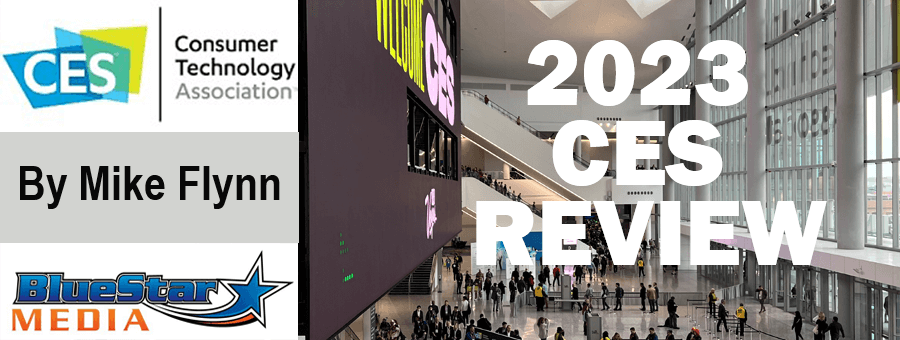
LAS VEGAS – The 2023 Consumer Electronics Show – known as the CES – finished its first big early January four-day spectator event since the covid outbreak and shutdowns of 2020. Last year’s CES was done via remote for many participants but this year the doors were open.
The CES which normally has over 300,000 attendees was down a bit as some people are still leery of travel and some potential exhibitors did not make the event due to a variety of travel, visa and medial issues. It doesn’t help when it falls on the same weekend of the NFL final season plus the Monday CFP championship game.
Without doubt this was a different show compared to my last trip here in 2020 right before the covid shutdown. It wasn’t until last February and early March before the virus fear gave many people pause to travel or congregate under any circumstance. Below is a deep dive covering five Hall over 17 hours of walking past booths and speed reading their products.
The biggest changes from the past is the opening of the new West Hall that took over empty land across from the Las Vegas Marriott. This glass-faced huge hall runs from across the street from the North Hall all the way down to almost Las Vegas Boulevard near Circus Circus. This new site took over the majority of exhibits dedicated to mostly automotive tech and products that was housed North Hall.
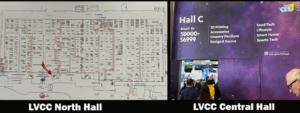
With the ascendancy of EV cars and all the accompanying tech from charging stations to self-driving technology to in-car communications and entertainment – this was the big new place to view the automotive future. The focus is now called Vehicle Tech and Advanced Mobility to reflect all kinds of technology. While most major US and foreign automakers did not have a monster presence (they have their own Auto Shows), their imprint was felt as many of the vendors are showcasing products and tech that can be utilities in their future products. The best products quickly viewed were the BWM car with changing color skin (similar to the indoor and background changing lights) and the RAM Truck which people loved. There’s even a Sony (Afeela) car in the work along with an Apple car in the near future.
The was some spill over from the West Hall into the old North Hall with Advanced Mobility. Added to this Hall was AI Robotics, Digital Health (items that were not placed in the Venetian Halls A-G across town), Enterprise business applications, some Fin Tech, and a lot of IoT (internet of things), This was where bigger booths and displays were housed that didn’t fit into the Venetian footprint of Smart Home or AR (augmented reality – virtual reality). Lot of uses for connectivity and augmented reality were shown here. This was a catch all space for companies seeking a bigger show footprint.
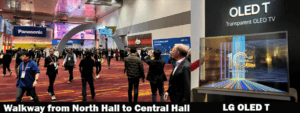
The Central Hall next door was the traditional electronics, photography and electronic components and AR glasses. This year the spaces were way bigger than the past with LG using their smaller curved screens for the monster visual wall entrance instead of the 100-inch connective panels from the past. LG’s four big items were the new 8K OLED tv, the transparent OLED T screen, the 97-inch wireless OLED M screen and their Ultra 240hrz monitor. Samsung which always has a variety of consumer and electron products got attention with their brighter 2nd gen QD OLED, a new 47-inch OLED gaming monitor and their 27-inch ViewFinity S9 to challenge Apple’s high def screen. Another Samsung concept is the “Flex S & G” screens which can used for tablets and phones in creative ways, Hisense (inexpensive min-LED screens), TCL (InkJet Printed OLED TV, Micro LED and new Mini LEDs) and Sony (PS5 2.0) mega-booths had similar products with tv screens dominating.
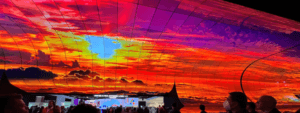
LG’s massive video wall consisting of smaller curved surfaces. In the past they used 100-inch connecting tiles for a flat wall effect as people entered their LG Pavilion from the North Hall-Central Hall connector. The curved surface allowed the picture to flow over the show attendees.
Microsoft and Sony introduced new video game controllers while Samsung amazed me with their new small chips the size of this X which will be the backbone of many new products in the future. HP had a wide double monitor while Lenovo showcased a dual screen computer.
Two screen outliers were the Corsair Xeneon Flex 45-Inch OLED (3440 x1440), 240Hz gaming monitor – a flat screen or a curved screen on demand. Most ingenious was Displace’s 55-inch fully wireless and power cord-less monitor which can be moved from walk to walk like a huge picture due to it’s ability to “stick” to a wall. These $3,000 screens can even be snapped together to create a larger full wall display and have a 4K pop-up camera on top for video conferencing and meetings. Both are worth going online to view on their websites.
The rest of the Central Hall had the usual suspects of mid-level companies and distributors of headphones, speakers, power systems and smaller company products were looking for buyers and distributors.
The opening of the West Hall gave the Convention Center the ability to shut down the two-level South Hall for renovations. This Hall traditionally had the early AR-VR technology (now more mainstream with the soon to be launched Apple Glasses) and a variety of Drone companies, the rage of 3-D printing and corporate meeting spaces. What changed was the drones were now missing except for a few in the Venetian Halls and the abundance of huge lounge chairs that vibrate and massage you as you lay back. Both the Central Hall and the Venetian A-D halls had numerous big booths covering these luxury products. These chairs had lines of people waiting to “relax” in them and “test” them out.
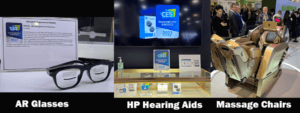
With the South Hall closed and these booths were spread among the back and side Central Hall and the Venetian Halls A-D (upstairs). Accessories was placed in the back while 3-D printing has its own smaller space up front. Five years ago the show was full of iphone cases, earphone and earbuds, headphones and speakers. Today these have been mostly replaced by newer tech. This space featured big display booths with all kinds of wifi, bluetooth and nest type (think Ring, etc.) connections from water management, temperature control, lighting and security, What was missing was the big home appliances booths not tied to the big Central Hall tv names probably due to the chip and component shortages of covid.
The highlight of any CES trip is always the hundreds of small booths in the lower Venetian Hall G (downstairs) that has Eureka Alley (203 booths for up-and-coming tech companies) along with the various country booths (over 300) that has startup and incubator technology. The range of products this time is centered around wearables (mobility), glasses, AR avatars and product development using AR and a variety of digital data. Clever interfacing products with targeted consumer (food, water, workout fobs & bands, communications, etc.) needs. Tech that uses data and cloud-based solutions were here too.
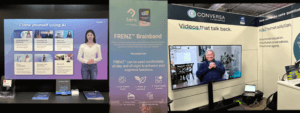
A lot of the “best in show” CES Innovation Awards to companies with cutting edge tech were downstairs in Hall G at the Venetian. Some then included: the stop snoring motion pillow, onAir commutate with light, EyeFit a machine vision tech to measure eye movement, a number of heart, glucose, breathing and elderly care. There was even a toilet seat to monitor your heart and a toilet fab to measure your urine.
Unless you are looking for specific tech, it’s important to cover the five major hall over the three day period (I left before the Sunday finale). This means endless slow walking and reading and only stopping to understand the product or connect the dots to some other tech. The catch-all stop was the CES Innovation section in Venetian Hall C where you can skip everything and just learn who got the coveted awards.
In the past there were some amazing technologies and new products but this year it seems as if connectivity, mobility, 3-D printers, and products offering new ways to use and create AR and VR headsets and glasses software to match the hardware were the majority of interesting products.
Beside the CES Innovation awards the big attraction for me to be here is to see the latest “Sports Tech.” There’s a section devoted to this near the Hall C entrance. In the past, this was a critical place to see what was coming ahead and were I found the 94fifty ball and the original Shot Tracker. After telling the Shot Tracker owners to “marry” this tech, they made a better product (we don’t see it much now) that was purchased by the Dodgers Tech Incubator. A ton of “fit-bit” type watches and bracelets have disappeared.
Other sport tech like Home Court (met the owner at a jrNBA meeting) and Huupe’s Smart Basketball Hoop were not here. Shockingly there was limited sport tech compared to three years ago. I think a lot of these new ideas and startup were victim of the covid shutdown, economics, and funding. I was disappointed as nothing was cutting edge if you take away the barrel full of tech wearables and bio-feedback strategies couple to the new “AI” concept.
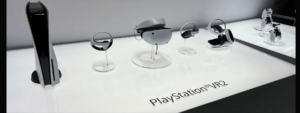
If you were looking for a variety of wearables, automotive & mobility solutions, health, home and entertainment packages (TVs, sound bars) then this was the place. If you wanted to see it future sport tech, it wasn’t here, only some ideas that in the future might be sport usable.
The two big takeaways from this year’s show is first the one you can witness now: the wireless IoT revolution which is still sorting itself out with so many companies offering sometimes different and competing products (controller, sensors, lighting). Everyone is familiar with Google, Ring (new car cam, indoor flying drone cam), TP-Link/Tapo, SwitchBot, Wyse, Eufy, Arlo, Reolink, Nest, Nanoleaf, SmartLife, Homey, Twinkly, Aqara, Govee, Flic, Yeelight, Eve and Apple (HomeKit). Add the new protocol Matter to the mix.
Right now there’s eight – yes 8 – different protocols which can be used to communicate with all these home, kitchen, appliance, entertainment, security and lighting products that use hubs, sensors, detectors, buttons and motors that use these protocols. When you choose a product to do A, like an outdoor security camera, you need power, communications, and storage system. When you want an indoor sensor will it connect to the security camera you just got? And the biggest hurdle is how to connect, power and manage these products we all want now?
Well, that’s why several companies try to sell you a suite of products to make it easier to plug and play. Unfortunately, you can’t get a B product to work with A unless you utilize one of these protocols. The eight protocols are: WiFi (6 for now at 2.4Ghz & 5Ghz), Bluetooth 5.0, 433Mhz, Z-Wave Plus (700 series), Zigbee (3.0), Infrared along with the mesh network connective It’s about power, IP-connectivity, authentication, and commissioning. Google Assistant, Amazon Alexa, Apple Siri are products use one or many of these protocols. Thread is a new networking protocol, and it will make Matter (a newer, agreed upon, new interoperability and connectivity protocol) work better by making it easier to connect smart devices to your home. You’ll see a majority of these IoT companies using this standard soon. Keep these two items in mind: power (PoE or Battery) and connectivity-communications (these protocols) when you want to buy or plan your Jetsons-like home.
It will be important to know what you want to connect now and in the future in your home/space and then understand the more you want, you’ll need a hub, system (Appl, Google, Nest, Ring, etc) and all the other devices you can add to the system. You can’t start with product A and try to add B and C without difficulty. This is why you need to know all these differences now because everyone wants these amazing products.
The second takeaway was new processor chips announced and their new abilities as they reach the limits of physical capabilities. AMD and Intel both used the CES to present their latest microprocessor chips. AI (OpenAI) requires a lot of speed along with designers and gamers. AMD’s new Zen 4 Ryzen 7000’s series of chips (7045HX series for laptops) is another step up in computing power despite the recent issues with Windows 11. Intel introduced with new 13th Gen HX mobile chips along with an H platform chips with the i9 13950HX chip leading the way. These products are about design and / or gaming and what people expect. AMD has their own GPU video cards and Nvidia usually pairs with Intel chips. Apple uses its own M2 chips for their products. Why am I telling you all this? It’s because no one is talking about all these companies reaching the (.3 nanometer) size limit along with the continual power (heat) consumption of these chips. The above won’t affect the general public. The next move is stacking (bigger layering chips) and possibly a move from silicon to graphene as a material.
Just think the 1946 Dick Tracey two-way radio watch came to fruition in 2015 with the Apple Watch. Who knows what products will be available in the next 10 years but you sure can connect some future dots at the CES.
NOTE: Don’t ignore the potential on the new rage OpenAI and the ChatGPT module platform which brings another level of communication to humanity. Coders, designers and students love its potential. It is now the rage across US college campuses and academia. The present 3.0 model is breathtaking in its ability to construct written research papers, essays and even movie dialogue. You can pare this “engine” to other AI programs covering design and photography. Right now it’s hard to get a free account as the OpenAI company has been bombarded with signups as it looks at a pay-model Chat 4.0 in the future.

Mike Flynn is owner and operator of Blue Star Basketball and U.S. Junior Nationals. He is a National Evaluator and publishes the Blue Star Report which ranks the top 100 high school girls basketball players in the nation. He also serves as Secretary of the Middle Atlantic District AAU, National Chair for AAU Lacrosse, Consultant to Gatorade for girls basketball, member of the McDonald's All–American selection committee, & Consultant for Nike Global Basketball.

Latest Articles
-
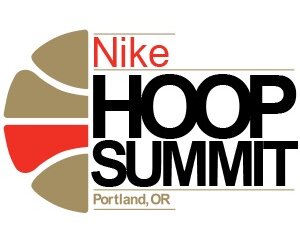

Christopher Lawlor
/ 2 weeks agoUSA sweeps World Team at Nike Hoops Summit; Flagg propels men’s team with 19 points while women’s team launches fourth quarter onslaught to complete rally
PORTLAND, Oregon – Call it sweet sweep for the Americans at the Nike Hoops...
-
Basketball
/ 2 weeks agoUConn Dominates College Basketball Again
GLENDALE, Ariz.– It wasn’t that all that long ago when UCLA, Kansas, North Carolina,...
By Dick Weiss -
Basketball
/ 2 weeks agoCalipari Move to Arkansas Leads to Seismic Shift
GLENDALE, Ariz.– The John Calipari era at Kentucky is over after 15 years....
By Dick Weiss -
Basketball
/ 3 weeks agoBig Men Take Center Stage in NCAA Title Game
GLENDALE, Ariz. — You wanted it. You got it. UConn’s 7-2 sophomore Donovan Clingan...
By Dick Weiss
